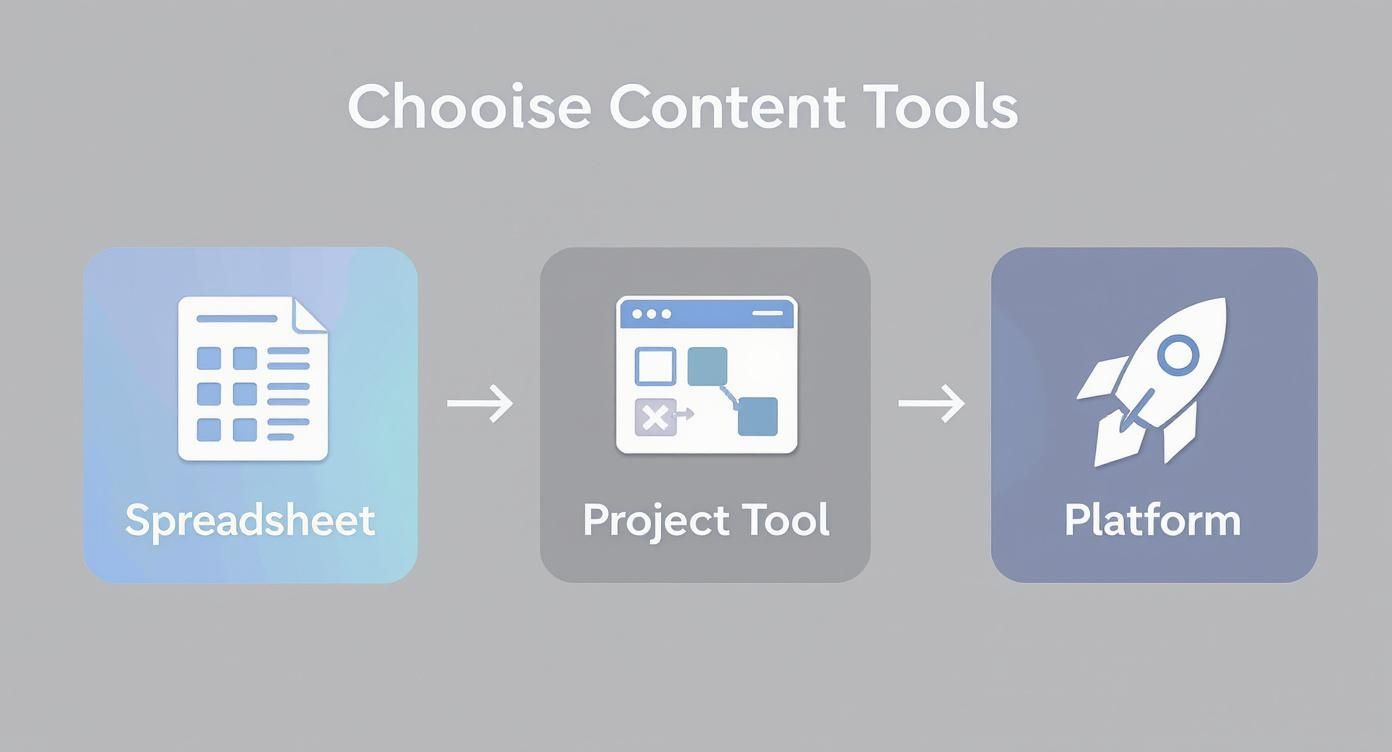Wondering what is a content calendar? Discover how this essential tool organizes your marketing, saves time, and helps you create content that actually works.
In This Article
Subscribe to our newsletter
At its core, a content calendar is a simple concept: it's a schedule that organizes all your upcoming content in one place. But thinking of it just as a schedule is selling it short.
Think of it as the command center for your entire content marketing operation. It's the tool that transforms your efforts from reactive, daily scrambles into a proactive, goal-driven system. It provides a clear, shared vision for what content will be published, where it's going, and when it needs to be live.
Your Marketing Blueprint for Success

Imagine trying to build a house without a blueprint. You might end up with a few walls, but they probably wouldn't connect properly. The final structure would be chaotic, unstable, and definitely not what you envisioned.
A content calendar is that essential blueprint for your marketing. It ensures every single piece of content you create—from a deep-dive blog post to a quick social media update—is part of a cohesive plan, not just a random act of content.
Instead of waking up and asking the dreaded question, "What should we post today?" a calendar gives you a clear roadmap. This strategic foresight is what separates successful brands from those who are just making noise online. To truly get the most out of it, you first need a solid content marketing strategy; the calendar is the tool you'll use to bring that strategy to life day in and day out.
To put it simply, here’s a quick breakdown of what a content calendar really does.
Content Calendar At-a-Glance
| Core Function | Primary Benefit |
|---|---|
| Centralized Scheduling | Ends the daily "what to post" panic and ensures consistency. |
| Strategic Planning | Aligns content with goals, campaigns, and key dates. |
| Team Collaboration | Creates a single source of truth for all content activities. |
| Performance Tracking | Provides a framework for measuring what works (and what doesn't). |
| Resource Management | Helps manage team workload and content production pipelines. |
As you can see, it’s much more than just a list of dates.
More Than Just a Schedule
While its primary function is scheduling, a robust content calendar does so much more. It acts as a single source of truth for your entire team, getting writers, designers, and marketers all on the same page and working toward common goals.
This organized approach offers some immediate, powerful advantages:
- Improved Consistency: A regular publishing cadence builds audience trust and keeps you top-of-mind. A calendar makes this happen automatically.
- Enhanced Collaboration: Everyone knows their role, what's due, and how their work fits into the bigger picture. This drastically cuts down on bottlenecks and miscommunication.
- Strategic Alignment: You can easily plan your content around key industry dates, product launches, or seasonal trends, making sure what you publish is always relevant and timely.
The shift toward this level of organization is clear in the market. The global calendar app market was valued at USD 5.71 billion in 2023, and it's projected to climb to USD 16.37 billion by 2030.
More to the point, the market for dedicated marketing calendar software is expected to grow from USD 15.26 billion in 2025 to USD 28.11 billion by 2034. This trend underscores just how vital strategic planning has become for modern marketing teams.
The Building Blocks of a Powerful Content Calendar

A great content calendar is so much more than a list of topics and publish dates. It’s a living document, a command center built from a few key components that, when brought together, turn your entire strategy into a well-oiled machine.
Think of it like this: just jotting down dates is like having a car chassis. It’s a start, but it won’t get you anywhere. To build a high-performance engine, you need the pistons, the spark plugs, the whole system working in perfect sync. Your calendar is no different. Without these essential "building blocks," you’re just tracking deadlines, not driving a content strategy.
Core Content Details
First things first. At a bare minimum, your calendar needs to answer the what, where, and when for every single piece of content. These are the non-negotiables that give everyone on the team the essential info at a quick glance.
- Content Topic or Headline: This is the big idea. A clear, working headline immediately tells everyone what the piece is about.
- Content Format: Is this a blog post? A TikTok video? An email newsletter? A LinkedIn carousel? Nailing down the format dictates the entire creative and production workflow.
- Target Publication Date: The firm deadline. This is the anchor for your entire production timeline, and everything else works backward from this date.
- Distribution Channels: Where is this content going to live and be promoted? Listing out the blog, YouTube, Instagram, and Twitter keeps your distribution plan from becoming an afterthought.
These details form the skeleton of your content calendar. They provide the fundamental structure you'll build everything else on.
Strategic and Operational Layers
Okay, with the basics covered, it's time to add the layers that transform your calendar from a simple schedule into a true strategic weapon. This is where you connect your content back to business goals and streamline your day-to-day operations. This is what separates the proactive, high-impact teams from the ones always stuck in reactive chaos.
A great content calendar doesn't just tell you what you're publishing next week. It tells you how that piece of content fits into your quarterly goals, who is accountable for it, and what its current status is. It’s a project management tool disguised as a schedule.
Here are the crucial components that add that strategic depth:
- Target Keywords: For any content that hopes to capture organic traffic, this is absolutely essential. Including the primary and secondary SEO keywords keeps the team laser-focused on search intent from the moment they start writing.
- Owner or Assignee: Simple, yet critical. Who is responsible for getting this piece across the finish line? Assigning an owner creates crystal-clear accountability and stops the dreaded "I thought you were handling that" conversation.
- Current Status: A simple dropdown menu with options like 'Drafting,' 'In Review,' 'Scheduled,' or 'Published' works wonders. A status tracker gives you a real-time, 30,000-foot view of your entire content pipeline, making it easy to spot bottlenecks before they derail your whole schedule.
When you bring all these building blocks together, your calendar becomes the central hub for strategy, collaboration, and execution. It’s how you guarantee every piece of content you create is purposeful, on-brand, and delivered right on time.
Why a Content Calendar Is Your Marketing Superpower
A content calendar does way more than just organize your schedule—it's the cure for your biggest marketing headaches. Without one, most teams operate in a state of constant, low-grade panic. You know the feeling: scrambling for last-minute ideas, pushing out whatever you can, and hoping it sticks. This reactive approach doesn't just burn out your team; it chips away at brand trust.
Think of the calendar as your strategic filter, turning chaos into clarity. It becomes the single source of truth that gets your entire team on the same page, from writers and designers to social media managers. Everyone knows what they’re responsible for, when it’s due, and exactly how their piece of the puzzle fits into the bigger picture. That kind of alignment is a game-changer for productivity.
From Reactive Scrambles to Proactive Strategy
Instead of the daily dread of, "What are we going to post today?" you can look weeks or even months ahead. This kind of foresight is where the magic happens. It lets you spot gaps in your content plan, making sure you cover all your key themes and actually address your audience's pain points.
It also means you can strategically plan content around holidays, industry events, or product launches. Your brand starts to feel timely and hyper-relevant, not like it's always a step behind.
This shift from reactive to proactive is where you’ll find the real power. You can start batching similar tasks—like outlining all of this month's blog posts in one go or filming a week's worth of videos in a single afternoon. This slashes the time lost to context switching and saves countless hours.
A content calendar doesn't just manage your time; it protects your focus. By eliminating the daily scramble for ideas, it frees up your team's creative energy to produce higher-quality, more impactful work that truly resonates with your audience.
Building Consistency and Trust Across Channels
If there's one thing that builds a strong brand, it's consistency. A calendar ensures a steady drumbeat of content that keeps your audience engaged and your brand top-of-mind. In today's ridiculously fragmented media world, this isn't just nice to have—it's essential.
The need for organized, multi-channel planning has never been greater. There are an estimated 5.42 billion social media users globally, and the average person hops between 6.84 different platforms every month. On top of that, 58% of consumers now discover new businesses through social media.
Without a calendar to coordinate your messaging, you risk sending mixed signals. A disjointed experience confuses your audience and seriously weakens your brand. You can read more about these social media trends on sproutsocial.com.
Ultimately, a content calendar is your superpower because it delivers:
- Clarity: Everyone knows what to do and when to do it. No more guesswork.
- Consistency: Your brand message feels coherent and trustworthy, no matter where people find you.
- Efficiency: You save a ton of time and dramatically reduce team stress.
- Strategy: Your content stops being random and starts being purposeful, directly supporting your business goals.
When you put a content calendar in place, you’re not just scheduling posts. You’re building a more resilient, effective, and far less stressful marketing machine from the ground up.
Finding The Right Content Calendar Tool For Your Team
Choosing the right platform for your content calendar is a bit like picking a vehicle for a road trip. A solo creator might only need a zippy scooter (like a spreadsheet) to get around town, while a big marketing team needs a fully-equipped tour bus (a specialized platform) to keep everyone moving forward together.
The best tool isn't always the one with the most bells and whistles. It’s the one that perfectly fits your team's size, budget, and the way you actually work.
You absolutely don't need a high-tech system to get started. Plenty of successful creators and small teams run their entire content machine from a simple spreadsheet, which offers incredible flexibility at zero cost.
Starting Simple With Spreadsheets
For many of us, the journey begins with Google Sheets or Microsoft Excel. These tools are familiar, infinitely customizable, and fantastic for organizing the basic building blocks of a content calendar. You can whip up columns for deadlines, topics, owners, and status updates in minutes.
This approach is perfect for individuals or small teams who just need a central place to track content without the headache of learning a new piece of software. It’s a low-friction way to bring order to your content chaos, starting today.
Graduating To Visual Project Management Tools
As your team and ambitions grow, you might find a spreadsheet starts to feel a bit static. The next logical step up often involves adapting visual project management tools like Trello or Asana into a content calendar.
These platforms use Kanban-style boards, letting you drag and drop content "cards" through different stages of production—from ‘Idea’ to ‘Drafting’ and all the way to ‘Published.’ This visual workflow gives you a powerful, at-a-glance overview of your entire content pipeline, making it incredibly easy to spot bottlenecks and manage everyone's workload. It strikes a great balance between structure and flexibility.
For instance, a Trello board can be set up with lists representing each stage of your content process.
Each card on the board can represent a single piece of content, holding checklists, attachments, and due dates, turning it into a dynamic hub for collaboration.
Scaling Up With Specialized Platforms
When your content operation becomes a serious engine for business growth, it’s time to look at a dedicated content calendar platform. Tools like CoSchedule or Loomly are built from the ground up for marketing teams and come packed with powerful features.
These platforms do a lot more than just scheduling. They often include:
- Automated Social Media Posting: Schedule and publish content across all your channels from one central hub.
- Integrated Analytics: Track content performance right inside the calendar to see what’s actually connecting with your audience.
- Approval Workflows: Set up structured review processes to make sure all content is on-brand and error-free before it sees the light of day.
- Asset Libraries: Keep all your creative assets—images, videos, and logos—organized and easy for the whole team to find.
While your calendar is central to planning, it often works alongside other systems. You might find value in exploring broader marketing campaign management tools that can plug into or complement your calendar.
Making the leap to a specialized tool is an investment, but the efficiency boost for a high-volume team is usually massive. It automates the tedious stuff, freeing up your team to focus on what really matters: creating brilliant content.
Choosing Your Content Calendar Tool
Deciding on the right format comes down to balancing simplicity against features. Here’s a quick breakdown to help you see where your team might fit best.
| Tool Type | Best For | Key Advantages | Potential Drawbacks |
|---|---|---|---|
| Spreadsheets | Solo creators, small teams, or those on a tight budget. | Infinitely flexible, no cost, and zero learning curve. | Lacks automation, can become clunky as the team grows. |
| Project Mgmt Tools | Growing teams who need a visual overview of their pipeline. | Great for collaboration, visual progress tracking, very intuitive. | Not built specifically for content, may lack marketing features. |
| Specialized Platforms | Established marketing teams and high-volume publishers. | All-in-one solution with automation, analytics, and workflows. | Higher cost and can require a significant setup period. |
Ultimately, the goal is to pick a tool that reduces friction, not adds to it. Start with what you need now, and don't be afraid to upgrade as your content strategy evolves and your team's needs change.
How to Build Your First Content Calendar Step-by-Step
Building your first content calendar can feel like a mammoth task, but it really just boils down to a few simple, logical steps. The goal isn't to create some color-coded, over-engineered masterpiece on day one. It's about building a functional tool that brings immediate order to your content chaos.
Think of it like putting together IKEA furniture. You lay out all the pieces, follow the instructions step-by-step, and before you know it, you’ve got a solid, useful structure.
1 Define Your Content Goals and Pillars
Before you can plan what you’re creating, you have to know why you're creating it. Is the mission to drive more traffic? Generate leads? Build brand awareness, or maybe just educate your existing audience? Your goals will be the north star that dictates every piece of content you prioritize.
Once the "why" is clear, it's time to identify your content pillars. These are the three to five big-picture topics your brand will own and talk about consistently. For a financial software company, these pillars might be "Small Business Accounting," "Tax Preparation," and "Invoice Management." Pillars keep your content focused, relevant, and on-brand.
2 Brainstorm and Research Topics
With your pillars locked in, we get to the fun part: brainstorming. Your job here is to generate a massive list of potential content ideas that fit neatly under each pillar.
Here are a few ways to get the ideas flowing:
- Answer Audience Questions: What are the top questions your customers are always asking? Every single one is a potential blog post, video, or social update.
- Keyword Research: Fire up your favorite SEO tool and see what people are actually searching for related to your pillars. Pay close attention to questions and long-tail keywords.
- Competitor Analysis: Scope out what your competitors are covering and where they're succeeding. Then ask yourself: how can we do it better or come at it from a completely different angle?
This stage is all about quantity, not quality. Just get every possible idea down on paper (or a doc). You'll sort through and schedule the gems later.
3 Choose Your Format and Populate the Calendar
Now, you need to pick the right tool for the job. It could be a simple spreadsheet, or maybe you need the power of a full-blown project management platform. This infographic shows the typical journey teams take as they level up their content operations.

The key takeaway here is that the right tool depends entirely on your team's current needs and where you're headed.
Grab your big list of brainstormed topics and start slotting them into your new calendar. Decide on a realistic publishing cadence—once a week? three times?—and start filling the dates.
For every piece of content you add, make sure to include the essentials:
- Working Title
- Content Pillar
- Content Format (e.g., blog, video, social post)
- Assigned Owner
- Status (e.g., Idea, Drafting, In Review)
- Publish Date
4 Establish a Simple Workflow
Your calendar tracks what you're creating, but a workflow defines how it all gets done. Map out the key stages every piece of content moves through—like outlining, drafting, design, review, and scheduling. This simple map creates a clear, repeatable process that kills confusion and prevents those dreaded bottlenecks.
In today's content world, this kind of planning is more critical than ever. The rise of AI and automation has completely changed the game. Over 80% of marketers are now using AI in their strategies, and 67% of small businesses are leaning on it for content creation and SEO. Content calendars have become the central nervous system for managing it all. If you want to dive deeper, you can find more content marketing statistics on typeface.ai.
Follow these steps, and you’ll trade in your strategic vision for a clear, actionable plan that actually gets content out the door.
Content Calendar FAQs
Even the best-laid content plans run into practical, on-the-ground questions. When you're in the thick of it, you need clear, simple answers to keep things moving.
Let’s tackle some of the most common questions marketers and creators ask.
How Far Out Should I Plan My Content Calendar?
There's no magic number here—it really depends on how fast your industry moves and how nimble your team is. A solid rule of thumb is to plan the day-to-day stuff, like blog posts and social media updates, about one month ahead.
This gives you a clear roadmap without locking you into a rigid plan you can't change. For the bigger picture, like a major product launch or a seasonal campaign, think in quarters. A quarterly plan helps you map out major themes and get your resources lined up way in advance, while still giving you the wiggle room to jump on new trends.
What’s the Difference Between a Content Calendar and an Editorial Calendar?
People often use these terms interchangeably, but there's a small difference that's actually pretty important.
An editorial calendar is usually all about the production side of things. It maps out topics, assigns writers, tracks review stages, and sets publication dates. Think of it as the project plan for long-form content like articles and videos.
A content calendar is the bigger picture. It doesn't just cover production; it maps out the entire distribution and promotion plan across every channel—social media, email newsletters, paid ads, you name it.
You could say the editorial calendar is a key piece that lives inside the larger, more comprehensive content calendar. The content calendar follows the journey from the first spark of an idea all the way to audience engagement.
How Do I Keep My Calendar From Being Too Rigid?
Your calendar should be a guide, not a straitjacket. The trick is to build flexibility right into the plan from day one.
Try scheduling "flex days" or "wildcard slots" each month. These are just empty spots you intentionally leave open to pounce on breaking news, share some cool user-generated content, or run with a spontaneous idea.
It also helps to have quick, weekly check-ins. These meetings let the team glance at the upcoming schedule and make fast adjustments based on what's trending or what the latest performance data is telling you. The goal is to be organized, not robotic.
Is a Content Calendar Even Useful for a Solo Creator?
Absolutely. In fact, it might be more critical for a solo creator or a tiny team. When you’re the writer, editor, and social media manager all in one, a content calendar is your single source of truth. It keeps you consistent and saves you from burnout.
It’s the key to batch-creating content, which is a massive time-saver. You can dedicate one day to outlining four blog posts or a single afternoon to filming a week's worth of TikToks. Instead of waking up every morning with that nagging "What am I going to post today?" feeling, you just look at your plan and execute. It frees up a ton of mental energy so you can focus on being creative and actually talking to your audience.
Ready to turn your content into high-performing video at scale? Aeon uses AI to transform your existing articles, audio, and ideas into engaging videos with minimal effort, driving traffic and boosting revenue. Learn how Aeon can streamline your video production.


.jpg)